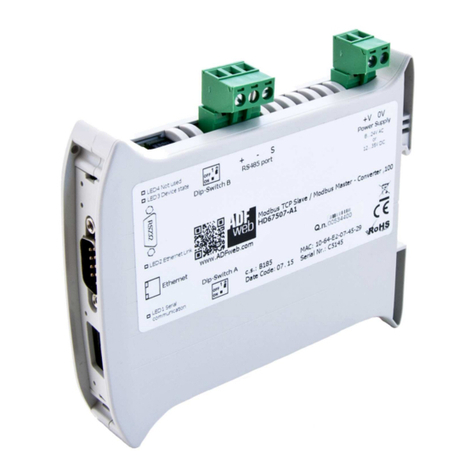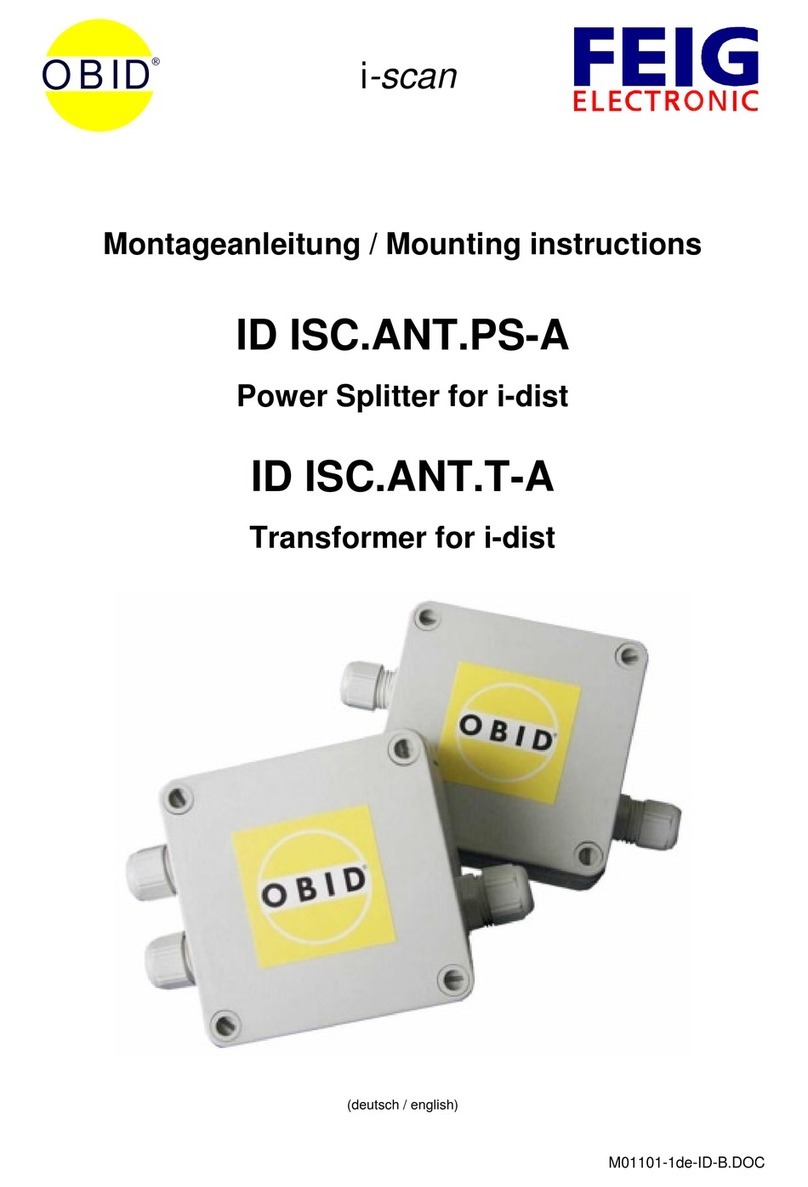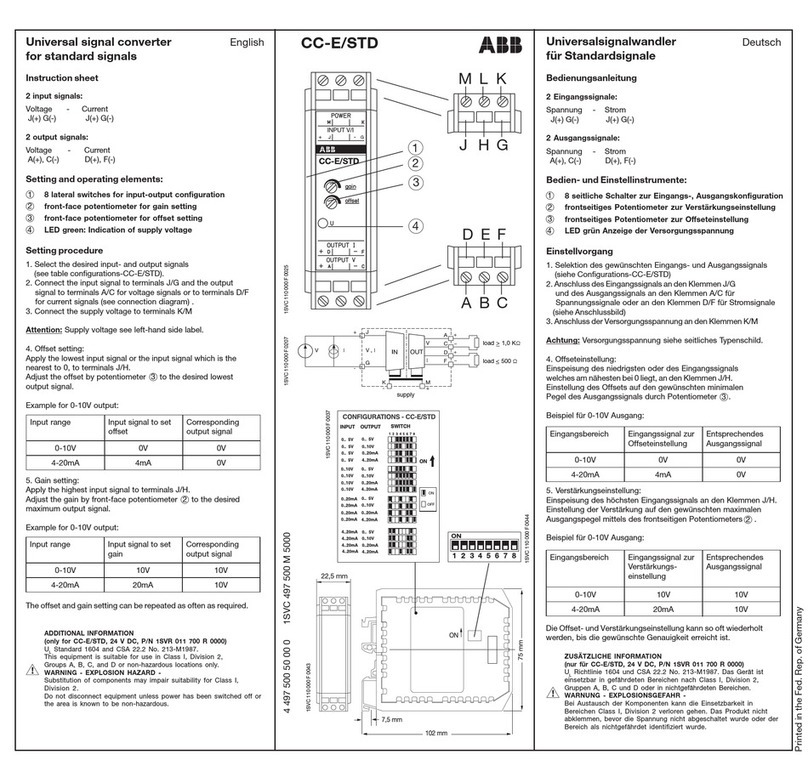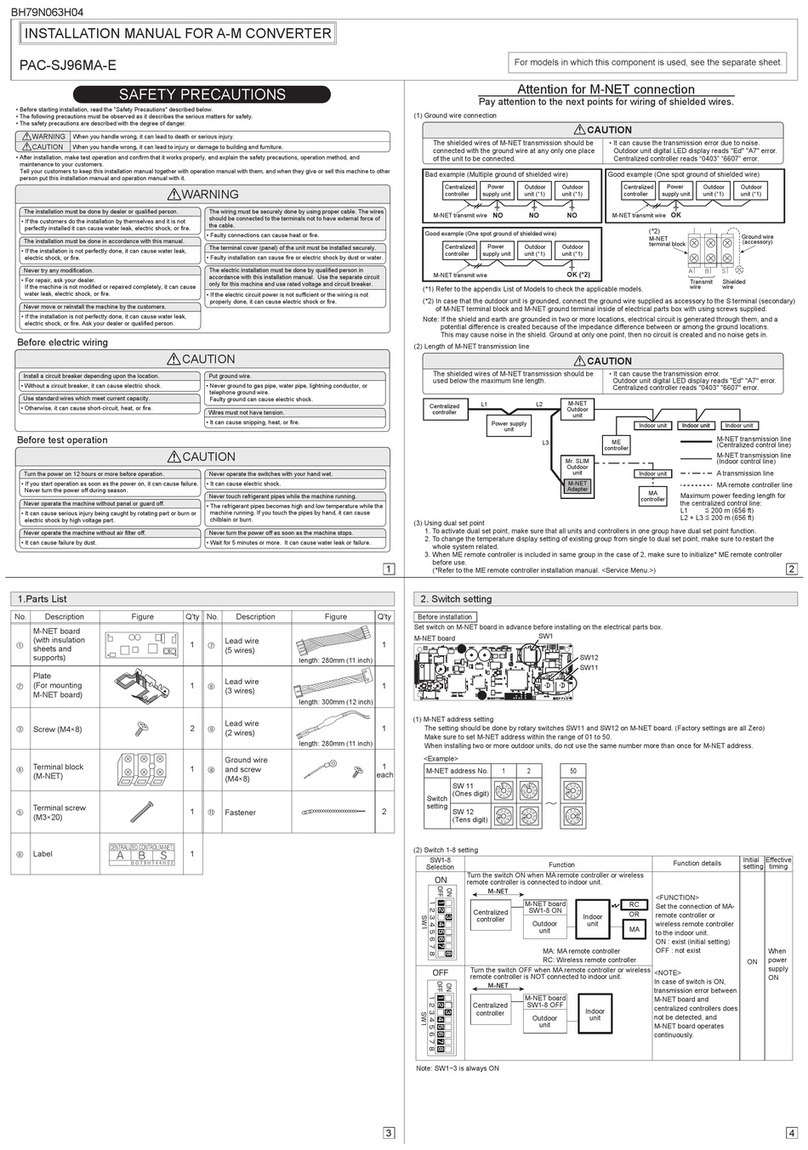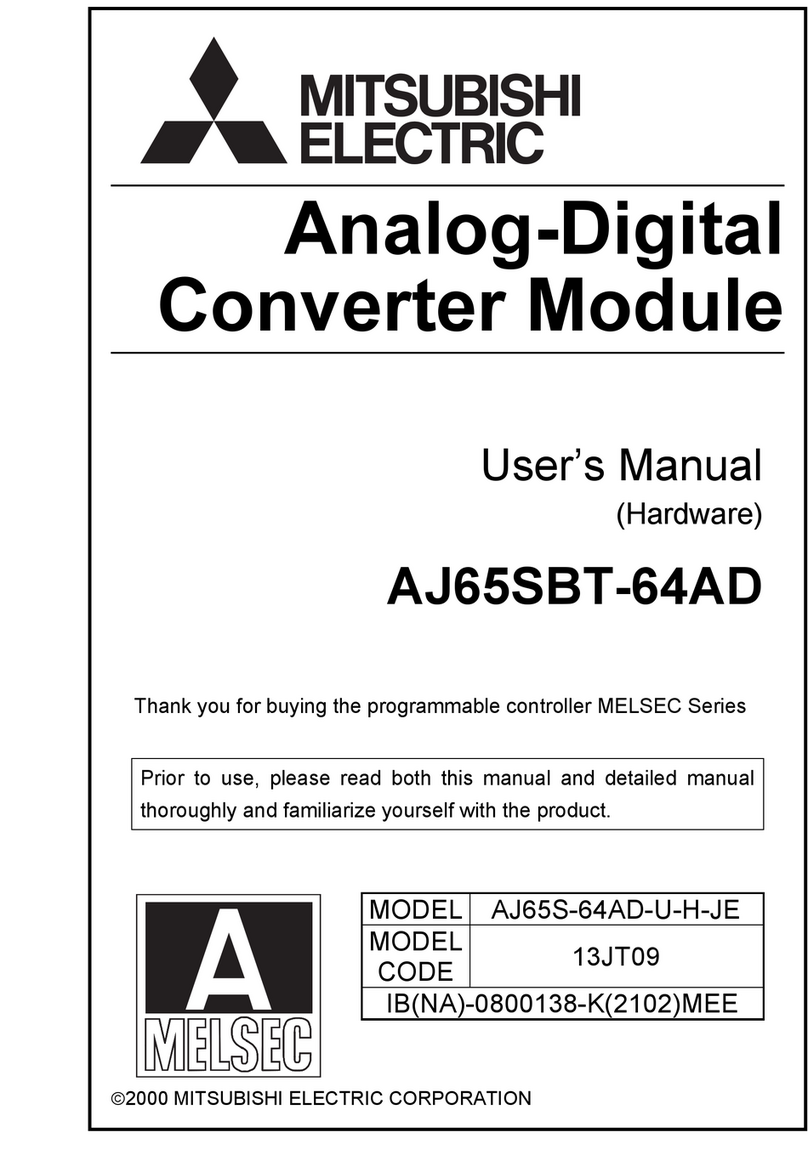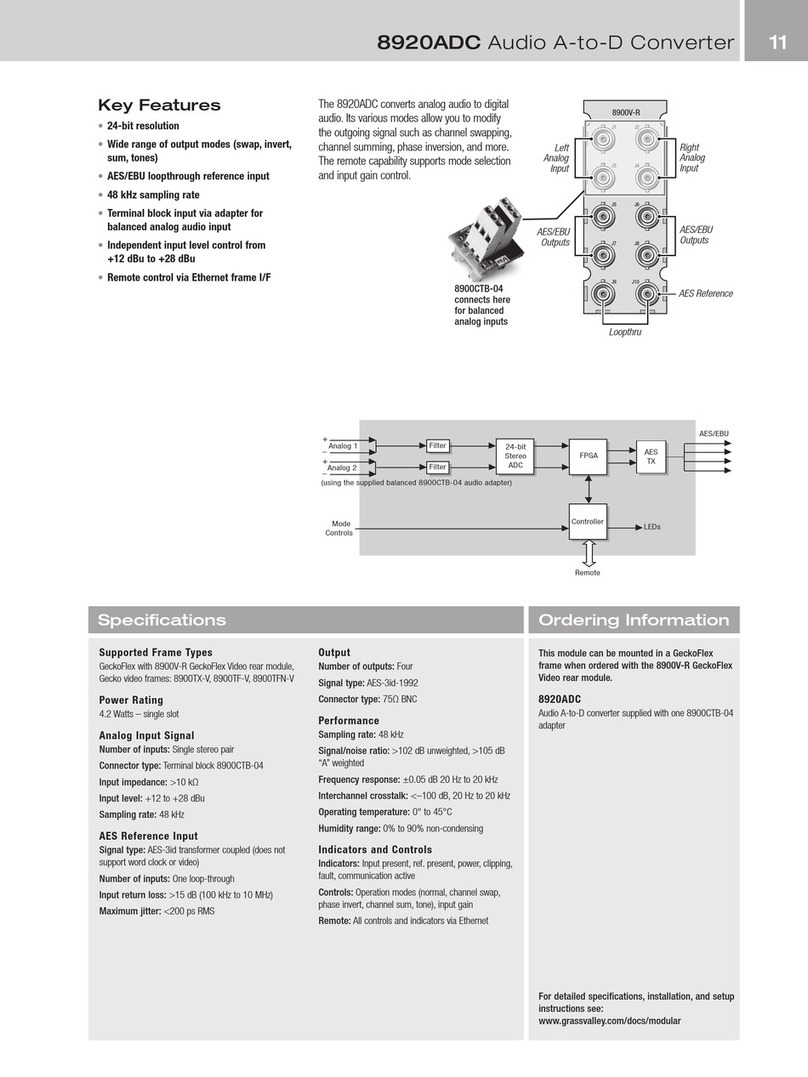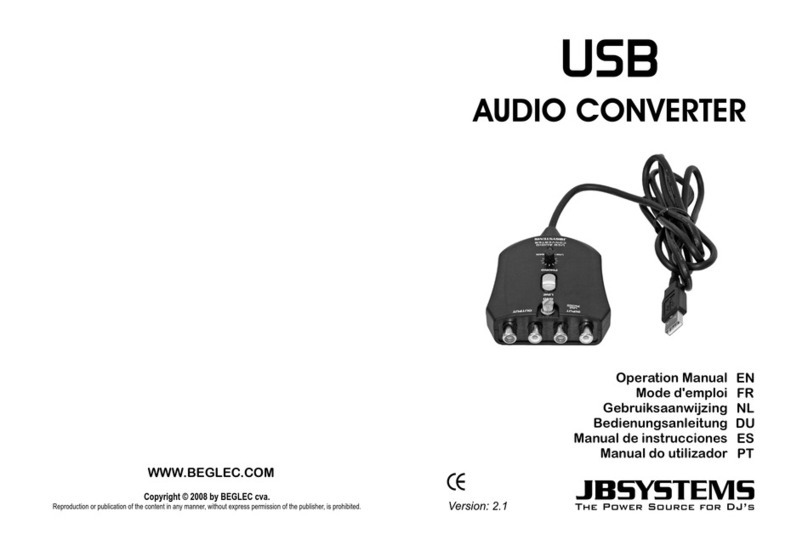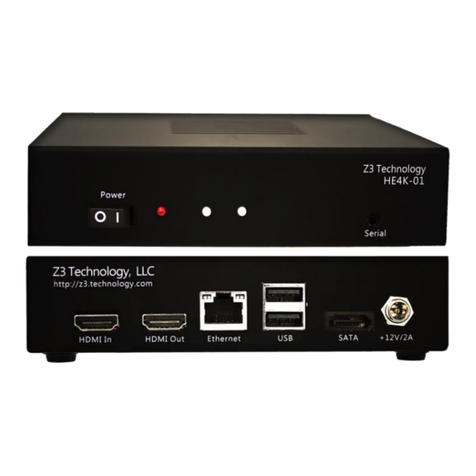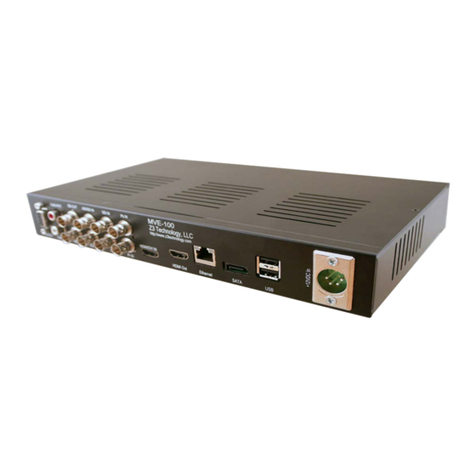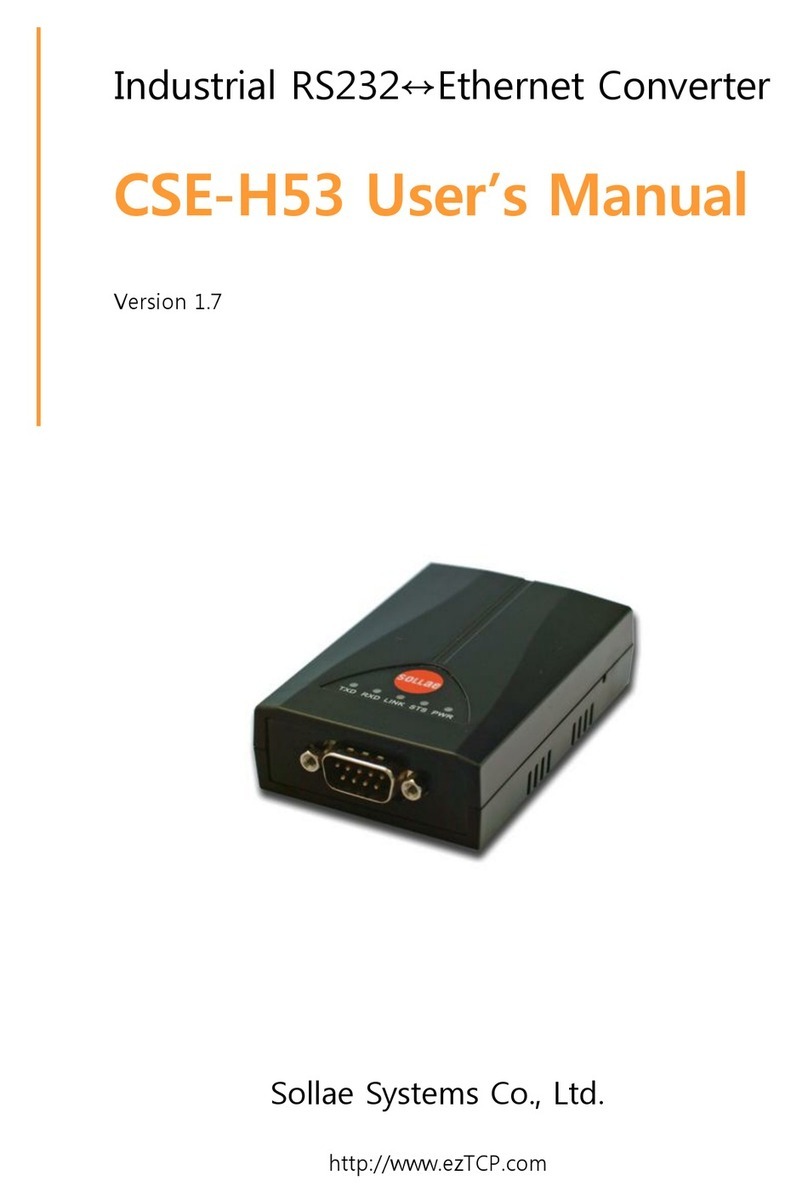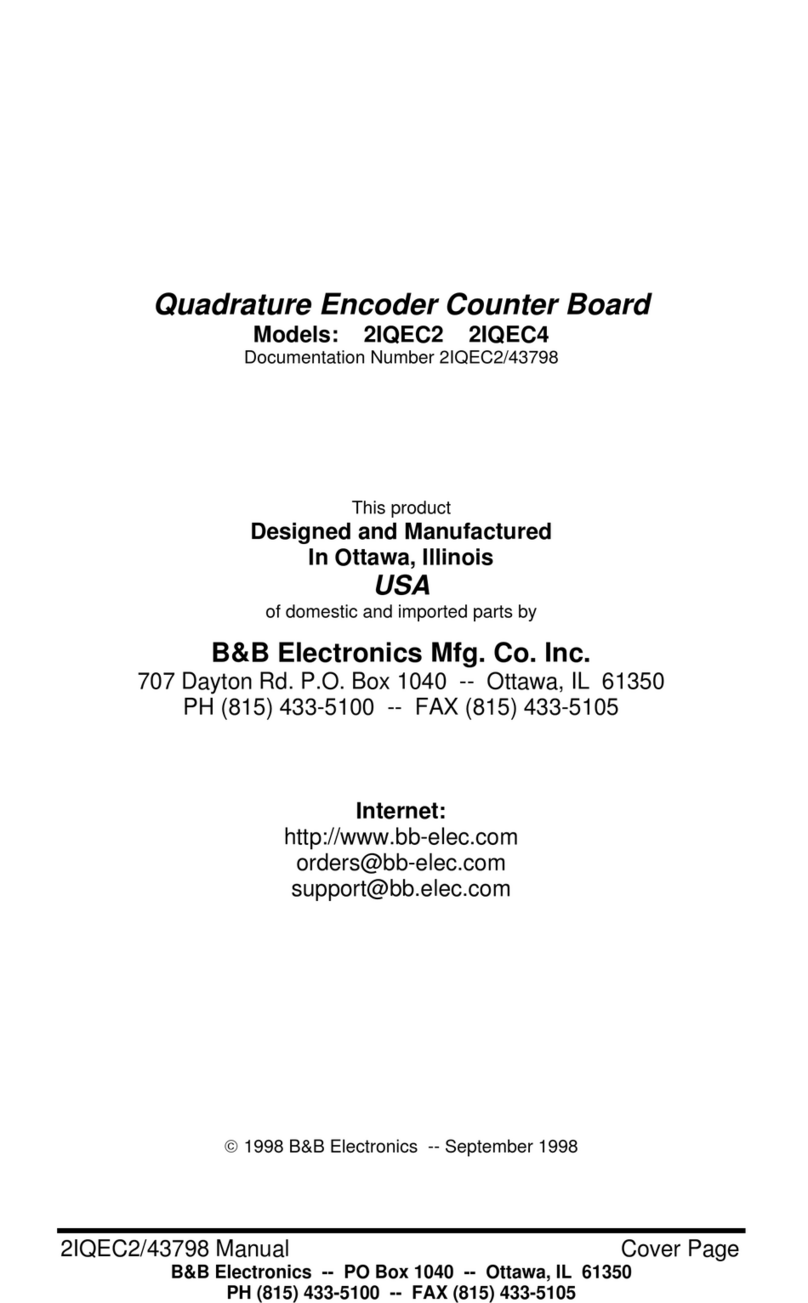epro CON 011 Manual

MMS Machine Monitoring Systems
Direction for use (GB) / Gebrauchsanleitung (D)
Converter CON 011
Date: 12.12.2006
6‘th Edition
6140-00029

Please note
In correspondence concerning this instrument, please quote type number and serial number as given on
the type plate and software version if applicable.
Bitte beachten
Bei Schriftwechsel über dieses Gerät wird gebeten, die Typennummer und die Gerätenummer wie auf
dem Typenschild aufgedruckt sowie, wenn vorhanden, die Softwareversion anzugeben
Important
As this instrument is an electrical apparatus, it may be operated only by trained personnel. Maintenance
and repairs may also be carried out by qualified personnel.
Wichtig
Da das Gerät ein elektrisches Betriebsmittel ist, darf die Inbetriebnahme und Bedienung nur durch
eingewiesenes Personal erfolgen. Wartung und Reparatur dürfen nur von geschultem, fach−und
sachkundigen Personal durchgeführt werden.
©epro GmbH
Jöbkesweg 3
D48599 Gronau
Germany
All rights are strictly reserved
Reproduction or divulgation in any form whatsoever is not permitted without written authority from the copyright owner.
Issued by epro GmbH
Printed in Germany

Page 3
Direction for Use (GB) / Gebrauchsanleitung (D)
Converter CON 011
1GB Direction for use 5. . . . . . . . . . . . . . . . . . . . . . . . . . . . . .
1.1 Purpose and Application 5. . . . . . . . . . . . . . . . . . . . . . . . . . . . . . . . . . . .
1.2 Function Principle 5. . . . . . . . . . . . . . . . . . . . . . . . . . . . . . . . . . . . . . . . . .
1.3 Installation and Comissioning 6. . . . . . . . . . . . . . . . . . . . . . . . . . . . . . .
1.3.1 Hints for installation and connection 6. . . . . . . . . . . . . . . . . . . . . . . . . . . . . . . . . . . . . . . .
1.3.2 Inherently safe installation 6. . . . . . . . . . . . . . . . . . . . . . . . . . . . . . . . . . . . . . . . . . . . . . . .
1.3.3 Adjustment of measuring chains at the machine 8. . . . . . . . . . . . . . . . . . . . . . . . . . . . . .
1.3.4 Mutual influences of two measuring chains 9. . . . . . . . . . . . . . . . . . . . . . . . . . . . . . . . . .
1.3.5 Recalibration of the converter ( only necessary in special cases ) 9. . . . . . . . . . . . . . .
1.4 Maintenance, Fault finding, Repair 10. . . . . . . . . . . . . . . . . . . . . . . . . . .
1.4.1 Maintenance 10. . . . . . . . . . . . . . . . . . . . . . . . . . . . . . . . . . . . . . . . . . . . . . . . . . . . . . . . . . . .
1.4.2 Hints for fault finding 11. . . . . . . . . . . . . . . . . . . . . . . . . . . . . . . . . . . . . . . . . . . . . . . . . . . . .
1.4.3 Repair 11. . . . . . . . . . . . . . . . . . . . . . . . . . . . . . . . . . . . . . . . . . . . . . . . . . . . . . . . . . . . . . . . . .
1.5 Technical Data 11. . . . . . . . . . . . . . . . . . . . . . . . . . . . . . . . . . . . . . . . . . . . . .
1.5.1 Input 11. . . . . . . . . . . . . . . . . . . . . . . . . . . . . . . . . . . . . . . . . . . . . . . . . . . . . . . . . . . . . . . . . . .
1.5.2 Supply 11. . . . . . . . . . . . . . . . . . . . . . . . . . . . . . . . . . . . . . . . . . . . . . . . . . . . . . . . . . . . . . . . . .
1.5.3 Output 12. . . . . . . . . . . . . . . . . . . . . . . . . . . . . . . . . . . . . . . . . . . . . . . . . . . . . . . . . . . . . . . . . .
1.5.4 Errors and tolerances 12. . . . . . . . . . . . . . . . . . . . . . . . . . . . . . . . . . . . . . . . . . . . . . . . . . . . .
1.5.5 Environmental conditions 13. . . . . . . . . . . . . . . . . . . . . . . . . . . . . . . . . . . . . . . . . . . . . . . . .
1.5.6 Explosion protection 14. . . . . . . . . . . . . . . . . . . . . . . . . . . . . . . . . . . . . . . . . . . . . . . . . . . . . .
2DGebrauchsanleitung 15. . . . . . . . . . . . . . . . . . . . . . . . . .
2.1 Zweck und Anwendung 15. . . . . . . . . . . . . . . . . . . . . . . . . . . . . . . . . . . . .
2.2 Funktionsprinzip 15. . . . . . . . . . . . . . . . . . . . . . . . . . . . . . . . . . . . . . . . . . . .
2.3 Installation und Inbetriebnahme 16. . . . . . . . . . . . . . . . . . . . . . . . . . . . .
2.3.1 Verkabelungs−und Anschlußhinweise 16. . . . . . . . . . . . . . . . . . . . . . . . . . . . . . . . . . . . . .
2.3.2 Explosionsgeschützte Installation 16. . . . . . . . . . . . . . . . . . . . . . . . . . . . . . . . . . . . . . . . . .
2.3.3 Einstellung der Messkette an der Maschine 18. . . . . . . . . . . . . . . . . . . . . . . . . . . . . . . . . .
2.3.4 Gegenseitige Beeinflussung zweier Messketten. 19. . . . . . . . . . . . . . . . . . . . . . . . . . . . .
2.3.5 Nachkalibrierung des Konverters (nur in Sonderfällen erforderlich) 19. . . . . . . . . . . . . .
2.4 Wartung, Fehlersuche, Reperatur 20. . . . . . . . . . . . . . . . . . . . . . . . . . . .
2.4.1 Wartung 20. . . . . . . . . . . . . . . . . . . . . . . . . . . . . . . . . . . . . . . . . . . . . . . . . . . . . . . . . . . . . . . .
2.4.2 Fehlersuchhinweise 21. . . . . . . . . . . . . . . . . . . . . . . . . . . . . . . . . . . . . . . . . . . . . . . . . . . . . .
2.4.3 Reparatur 21. . . . . . . . . . . . . . . . . . . . . . . . . . . . . . . . . . . . . . . . . . . . . . . . . . . . . . . . . . . . . . .
2.5 Technische Daten 21. . . . . . . . . . . . . . . . . . . . . . . . . . . . . . . . . . . . . . . . . . .
2.5.1 Eingang 21. . . . . . . . . . . . . . . . . . . . . . . . . . . . . . . . . . . . . . . . . . . . . . . . . . . . . . . . . . . . . . . .
2.5.2 Speisung 21. . . . . . . . . . . . . . . . . . . . . . . . . . . . . . . . . . . . . . . . . . . . . . . . . . . . . . . . . . . . . . .
2.5.3 Ausgang 22. . . . . . . . . . . . . . . . . . . . . . . . . . . . . . . . . . . . . . . . . . . . . . . . . . . . . . . . . . . . . . . .
2.5.4 Fehler und Toleranzen 22. . . . . . . . . . . . . . . . . . . . . . . . . . . . . . . . . . . . . . . . . . . . . . . . . . . .
2.5.5 Umgebungsbedingungen 23. . . . . . . . . . . . . . . . . . . . . . . . . . . . . . . . . . . . . . . . . . . . . . . . . .
2.5.6 Explosionsschutz 23. . . . . . . . . . . . . . . . . . . . . . . . . . . . . . . . . . . . . . . . . . . . . . . . . . . . . . . .

Page 4
Direction for Use (GB) / Gebrauchsanleitung (D)
Converter CON 011
3 Figures / Abbildungen 25. . . . . . . . . . . . . . . . . . . . . . . . . . . . . . .
Fig 1: Block diagram / Blockschaltbild 25. . . . . . . . . . . . . . . . . . . . . . . . . . . . . . . . . . . . . . . . . . . .
Fig 2: Layout of CON 011 / Bauteileanordnung CON 011 25. . . . . . . . . . . . . . . . . . . . . . . . . . . .
Fig 3: Characteristical curve / Kennlinie 26. . . . . . . . . . . . . . . . . . . . . . . . . . . . . . . . . . . . . . . . . . .
Fig 4: Shaft vibration signal, example / Wellenschwingungssignal, Beispiel 27. . . . . . . . . . . .
Fig 5: Connection diagram, example / Anschlußdiagramm, Beispiel 27. . . . . . . . . . . . . . . . . .
Fig 6: Connection diagram for intrinsically safe installation /
Anschlußdiagramm für eigensichere Installation 28. . . . . . . . . . . . . . . . . . . . . . . . . . . . . .
Fig 7: Cable end prepared for connection to CON 011 /
Kabelende vorbereitet für Anschluss an CON 011 28. . . . . . . . . . . . . . . . . . . . . . . . . . . .
Fig 8: Dimensions / Abmessungen 30. . . . . . . . . . . . . . . . . . . . . . . . . . . . . . . . . . . . . . . . . . . . . . .
Fig 9: Measuring arrangement for calibration / Messaufbau für Kalibrierung 30. . . . . . . . . . . .

Page 5
Direction for Use (GB) / Gebrauchsanleitung (D)
Converter CON 011
Direction for use
1
GB DIRECTION FOR USE
1.1 Purpose and Application
The CON 011 Signal Converter in combination with sensors of type PR 6422 ... PR 6426 of epro
Machine Monitoring Systems form eddy current measuring chains to be used for static and
dynamic distance measurements at all kinds of rotating machinery. This means that slow axial
displacements as well as fast radial vibrations of rotating machines can be measured. By using
pulse wheels or key marks sticked on the shaft, the speed of the machine can be measured and
key pulses generated.
Probes and signal converters are adjusted together and are delivered as complete measuring
chains in order to achieve a maximum accuracy. For this reason it is very important that probes
and converters always operate together. The type of the sensor and its serial number are marked
on the type plate of the converter.
The characteristics of the measuring chain are adapted to the material mainly used for
turbomachinery (reference material: 42 Cr Mo 4, according to SAE 4140). The standard
adjustment of the measuring chains is generally related to this material −if necessary, other
materials can be used for the adjustment (refer to operating manual PR 6422...PR 6426). During
installation at the machine only the distance between the head of the sensor and the measuring
target are to be adjusted. Criterion for the adjustment of the sensor is the output signal of the
converter.
The CON 011 Signal Converter is accommodated in a rugged housing, the electronic
components are completely sealed. Connection of the eddy current probe is made with a
LEMOSA connector at the front of the converter. A M20 tapped bush allows the protection of
the sensor cable by means of a cable protection tube set MPT 064/.. . Supply circuits for the eddy
current probe and the measuring electronic are contained in the converter. The nominal supply
voltage for the converter is 24VDC, the nominal range of the output signal −proportional to the
nominal measuring range of the sensor−may be set to either –4...−20 or –2...−18V. With the
converters for the special measuring range (CON 011 / 91x−xxx) the output voltage is firmly
adjusted to the range −4... −20V.
Five eddy current probes are at disposal. The actual type to be used depends on the measuring
range, on the available space for measuring and on the environmental temperature.
1.2 Function Principle
The measuring coil of the eddy current sensors PR 6422...PR 6426 is connected to an oscillator
circuit in the converter via a screened connection cable (see Fig 1).
The oscillator circuit generates a high frequent signal, thus resulting in a high frequent magnetic
field around the tip of the eddy current probe. If this magnetic field meets a metallic target, it
induces high frequent currents and another magnetic field which is inversely induced to the
original one. According the rule of Lenz, the induced currrent damps the oscillator signal.
The damping factor depends on the distance between sensor head and target material. The
smaller the distance to the sensor, the smaller the amplitude of the oscillator.

Page 6
Direction for Use (GB) / Gebrauchsanleitung (D)
Converter CON 011
Direction for use
The demodulator at the output of the oscillator generates a low−frequent signal from the
amplitude modulated HF– signal. The following units serve the purpose of linearization and
amplification of the signal. The output connectors OUT and ⊥provide a signal proportional to
the actual distance between sensor head and target material.
1.3 Installation and Comissioning
1.3.1 Hints for installation and connection
To ensure the electromagnetic compatibility of the eddy current measuring chain, we
recommend using double screened twisted pair cable for connecting the signal converter to the
measuring amplifier. For direct connections to the converter, cables of type LiYCY – CY
2x2x0,25 mm@should preferably be used. Master connection cable may be any multicore cable
with a corresponding cable structure. We recommend to connect the outer screen of the cable
to protective earth/measuring ground close to the measuring amplifier directly at the cable inlet
of the control cubicle. Moreover, the outer screen of the cable should be connected to protective
earth as often as possible i.e. at every intermediate distribution frame or cable gland.
An extremely high electromagnetic compatibility can be achieved by connecting the cable
screen to protective ground at either side of the cable – provided that no compensating current
goes over the screen. The signal converter CON 011 is provided with a specific cable gland M16
which allows proper connection of the screen to the CON housing, see Fig 5 and Fig 7. In case
of high disturbances it might be useful to connect the screen only to the housing of the CON.
The internal cable screens must be fed through the cable glands of the CON and then precisely
cut off, refer to the wiring scheme Fig 7. In the control cubicle, close to the measuring amplifier,
the screen has to be connected to 0V / common. Connection of the wires is to make according
to Fig 5.
In case that only cables of type LiYCY−CY 2x2x0,25mm@are used, the maximum cable length
is 400m, if longer cables are used an intermediate distributor must be set close to the converter
and cables with a higher cross section used for connection to the measuring amplifier (e.g.
LiYCY−CY n x 2 x 1,5 mm@).
•Measuring cables have to be installed according to general standards for measuring and
control cables and, if possible, in metallic cable channels or tubes. It must be observed that
the measuring cables are arranged orthogonally.
•Close CON housing carefully and observe the correct position of the rubber sealing ring.
•At special applications, where high static discharges(> 6kV) could occur, it must be checked
whether the ground connection via the mounting screws are sufficient. In this case it could
be useful to connect the CON housing to protective earth with an extra cable.
1.3.2 Inherently safe installation
On the following conditions, the sensors PR 6422 ... PR 6426 together with the CON 011 signal
converter may be used for applications in hazardous areas for zone 0, protection class
”Inherently safety” – EEx ia IIC T6 :

Page 7
Direction for Use (GB) / Gebrauchsanleitung (D)
Converter CON 011
Direction for use
Connection must be made according to Fig 6 e.g. via safety barriers from Stahl of type:
Supply circuit: 9001/00−280/085/101
Measuring circuit: 9001/00−280/020/101
The safety barriers must be installed outside the explosive area in cabinets or control cubicles
with protection classes of at least IP 20 according to DIN 40 050.
In order to achieve compensations of electric potentials, the connectors for protective earth of
the barrier (mounting screw, internally connected to pin 2) must be linked to the corresponding
protective earth connectors within the explosive areas via a compensation line. The mounting
rail for the safety barriers has to be isolated.
The compensation line has to be rated according to VDE 0100 ’ 9 N, table 2 and ’ 21 Nb 1.1 to
1.4, minimum cross section 1,5 mm@Cu. The connection terminals of these safety barriers may
be used for cables with cross sections of up to 2,5 mm@.
The total capacity is calculated from the sum of the capacities at the sensor input (refer to section
1.5. technical data), at the measuring signal output (between Out, ⊥and screen) and at the
supply input (–24 V, ⊥and screen). The capacity of the sensor circuit amounts to 1,2nF (cable
length 10m). Thus, the maximum permitted cable capacity between converter and safety
barriers is for protection class IIC: CLmax = 49 nF and for IIB: CLmax = 616 nF (wire / wire
and wire / screen). The maximum permitted line inductance between converter and safety
barriers is LLmax = 1,6 mH for IIC resp. LLmax = 8 mH for IIB. The following table shows the
resulting cable length l between converter and safety barrier:
Protection class: IIC IIB
•Cable LiYCY−CY 2x2x0,25 and
meas. cable PT 1492/00 with C = 2 x 150nF/km Lmax = 163 m > 1000 m
•Low capacity cables C = 2 x 60nF/km, Lmax = 408 m > 1000 m
e. g. Li2YCY (TP)
In case of extremely long cables between safety barriers and measuring amplifiers, the upper
cut−off frequency might be reduced by the series resistor of the barrier (1510 Ω) and the line
capacity:
3dB at f = 2kHz and CL= 50nF, corresponding to 330m cable length with 150nF/km
1dB at f = 2kHz and CL= 25nF, corresponding to 165m cable length with 150nF/km
!When operating the CON 011 Signal Converter in hazardous areas, the instal-
lation has to be carried that the converter is not exposed to strokes or mecha-
nical shocks and friction of metallic parts at the converter housing is avoided.
Since the housing is installed steadily at the machine and must not be cleaned, there is no
danger of electrostatic charges of the plastic parts.

Page 8
Direction for Use (GB) / Gebrauchsanleitung (D)
Converter CON 011
Direction for use
1.3.3 Adjustment of measuring chains at the machine
Connect converter supply −24Vdc (+24V to ⊥). Fit connector of sensor to converter input.
Measure output level at pins OUT and ⊥.
Sensor PR 6422...PR 6425:
•Loosen the lock nut from the sensor.
•For mounting and turning the sensor remove the sensor cable to avoid twisting of the cable.
•Turn the sensor in the holder as long as the nominal distance between sensor head and
measuring target is reached and the voltmeter indicates the desired point on the
characteristical curve.
•For measuring shaft vibrations it is sufficient to adjust the sensor to an output value of 12V
resp. 10V ±1V.
•For static measurements a precise adjustment to one output value is required, the sensor
is preferably set to one of the three output levels of the CON 011:
→for symmetrical displacements around the centre point (see Fig 3, Ace) to −12V
(−4...−20V) or –10V (−2... −18V) ±0,05V (recommended procedure)
→for the measuring range minimum (= minimum distance) to –4V (−4...−20V) resp. –2V
(–2...−18V) ±0,05V for single−sided movements to greater distances (Fig 3, Amin)
→for the measuring range maximum (= maximum distance) to –20V (−4...−20V) resp.
–18V (–2...−18V) ±0,05V for single sided movements to smaller distances. (Fig 3,
Amax)
→or to any other value within the measuring range when different distances in both
directions must be measured.
•Fix the sensor by means of the lock nut. The maximum torque is:
PR 6422: 1Nm (0,1 kpm); PR 6423: 15Nm (1,5kpm);
PR 6424 and PR 6425: 100Nm (10kpm).
Sensor PR 6426:
If the distance between mounting flange and measuring target is not correct, it must be adjusted
by shifting the mounting flange (refer to Fig 7 of the operating manual PR 6422...PR 6426). In
order to achieve a precise adjustment, we recommend using a linear guided support e.g. a dove
tail bearing. Special solutions for the customer’s application can be designed and produced at
epro’s on request.
Adjust the distance between sensor and measuring target by shifting the support, until the
con−verter output signal has reached the required point of the characteristical curve.
•−12V (−4...−20V) or –10V (−2...−18V) ±0,05V for symmetrical displacements around the
centre point (see Fig 3, Ace) (recommended procedure)
•the measuring range minimum (= minimum distance) – 4 (−4...−20V) resp. –2V (–2...−18V)
for single sided displacements in direction to greater values (greater distances) (Fig 3, Amin)

Page 9
Direction for Use (GB) / Gebrauchsanleitung (D)
Converter CON 011
Direction for use
•the measuring range maximum (= maximum distance) −20V (−4...−20V) resp. –18V (–2...
−18V) for single sided displacements in direction to smaller values (smaller distances)
(Fig 3, Amax)
•or any other value within the measuring range if different displacements in both directions
are to be measured (unsymmetrical measuring ranges)
Fix the mounting flange in the correct position and secure screws and nuts to prevent them from
getting loose. The sensor must be mounted vertically to the measuring target.
1.3.4 Mutual influences of two measuring chains
If two eddy current measuring chains are mounted close together, it might happen that they
influence each other and generate invalid measuring results. This could e.g. happen with a shaft
vibration measurement by using two PR 6423 sensors, mounted in an 90°angle at a shaft with
≤100mm diameter, in case of measuring shaft displacements with two sensors in tandem
arrangements, with cone or double cone arrangements of two sensors.
In this case the carrier frequency must be slightly shifted at one of the converters by opening link
J1 (e.g. with side−cutting pliers). After this, the measuring chain must be calibrated anew,
refer to section 1.3.5.
1.3.5 Recalibration of the converter ( only necessary in special cases )
The adjustment is made with a micrometer calibration device, refer to Fig 9.
STOP
Before soldering at the converter, switch off the supply power.
!To change the output voltage range from –2...−18V to –4...−20V, link J2 must
be opened. This action does only change the voltage range without any
influence on linearity or adjustment of the measuring chain.
Opening of link J1 increases the oscillator frequency of the converter by approx. 250 kHz, a new
adjustment of the measuring chain according to the following description is necessary. The
position of the components is shown in Fig 2.
Adjustment sequence for PR 6422...6424 and PR 6426:
Adjustment steps: [...] values are valid for J2 open
1. Desolder resistances R 22 (gain factor, approx. 0...10kΩ) and R 23 (zero point, approx. 10kΩ
...200kΩ) and connect resistance decades to these positions. Set potmeter GAIN to centre
position. Resistance R24 depends on the sensor type:
PR 6422 / 6423 / 6425: 4,02kΩ, PR 6424: 5,62kΩ, PR 6426: 10kΩ.

Page 10
Direction for Use (GB) / Gebrauchsanleitung (D)
Converter CON 011
Direction for use
2. Set distance measuring target −sensor head to minimum gap (PR 6423: 500μm, refer to
operating manual PR 6422...6426, section 1.3.2)
3. Set output level to −2,00V [−4,00V] with potmeter R23.
4. Set distance to half the meas. range (+ minimum gap) (PR 6423: 1500μm)
5. Calculate difference between output voltage and −10,00 V [−12,00V] . Adjust output voltage
with R 22:
→at Uout > −10V [−12V] reduce it by twice the difference,
→at Uout < −10V [−12V] increase it by twice the difference.
Example: Measured value (centre of the range) Adjustment value (with R 22)
Uist > −10V: −10,50V −9,50V
Uist < −10V: −9,00V −11,0V
6. Repeat steps 2...5 till optimum accuracy is reached (1%).
7. Set distance to full range (+ minimum gap) (PR 6423: 2500μm)
→If the output voltage is −18,00V [−20,00V] (max. ±1%), the adjustment is correct, go
on with step 8.
→If the output voltage is < −17,8V [−19,8V] repeat the adjustment with a slightly reduced
minimum gap according to steps 2...6 (PR 6423: e.g. 490μm)
→With output voltages > −18,2V [−20,2V] repeat the adjustment with a slightly increased
minimum gap according to steps 2...6 (PR 6423: e.g. 510μm).
8. If the distances at −2V, −10V and −18V [−4, −12 and −20V] are within the tolerances, check
the linearity at intermediate steps −4 V, −6 V, −8 V.... .
9. Set the distance to the full range, and note the output voltage. The resistance values for R22
and R23, found with the decades, must now be soldered as fixed resistors.
After the resistors have cooled down, set the output voltage with potmeter GAIN to the value
you have just noted.
10. Check the linearity according to step 8.
1.4 Maintenance, Fault finding, Repair
1.4.1 Maintenance
During operation, sensors and converter do not require any maintenance. High sophisticated
materials and a rugged construction ensure undisturbed operation and a long life time, even in
harsh environments.

Page 11
Direction for Use (GB) / Gebrauchsanleitung (D)
Converter CON 011
Direction for use
1.4.2 Hints for fault finding
For quick fault finding we recommend the provisional connection of an identical sensor to the
converter. If the head of the sensor is moved to a metallic target, the output voltage of the
converter must change from approx. −20 V[−18 V] to −4V [−2V].
In case the converter input is open or short−circuit, the output voltage should amount to approx.
0.3V. The open converter input does not show any supply voltage or supply frequency.
Eddy current sensors consist of a low−impedance coil, i.e. with a resistance measurement it is
only possible to detect a break of the cable. A detection of short−circuits or defective coils is not
possible. The cable screen must be isolated from the converter housing, from the metal
protection tube and from the housing of the LEMO connector. One possible error source could
be a missing or uncorrect shrinkage tube at the adapter between sensor and connection cable
(at the protection tube cable in the protection sleeve).
1.4.3 Repair
Due to a compact design and the high reliability, it is not intended to repair the signal converters.
In case of defects, the signal converters must be replaced. In this case it is recommended to
return the sensor to the factory to get a precise adjustment for the measuring chain with the new
converter. If this should be not possible, all information stated on the type plate of the converter
together with the exact type of converter and sensor and the exact material designation of the
measuring target must be defined.
The typical exchange error with substitution of the sensor or converter including an internal
reference alignment at epro averages 1.5% −2%. Epro assures a maximum exchange error of
5% related to the measuring range final value.
1.5 Technical Data
Only specifications with tolerances are guaranteed. Data without tolerances are not guaranteed
and are only for information purposes. If not stated otherwise, the specifications are valid for the
nominal supply voltage −24V.
1.5.1 Input
Connection for eddy current sensors self locking LEMO socket, impermeable to presswater
for connection of epro sensors PR 6422.... PR 6426.
1.5.2 Supply
Supply voltage range: −23 ... −32V for output voltage range −4..−20V
−21 ... −32V for output voltage range −2..−18V
−18 ... −21V with reduced output voltage range
Nominal supply current: < 15mA, with 10KΩload resistance
Reverse connect protection Reverse connect protection of all 3 terminals
(common, output, −24V)
Nominal operating frequency: approx. 1,25 MHz
De−adjustment of oscillator for
adjacent arrangement of sensors: open link J1 (delivery state: closed)

Page 12
Direction for Use (GB) / Gebrauchsanleitung (D)
Converter CON 011
Direction for use
1.5.3 Output
d.c. voltage with superimposed ac signal corresponding
to vibration or displacement of the shaft.
Open−circuit and short−circuit proof.
Output voltage range: J2 closed: −2... −18V (factory setting),
J2 open: −4... −20V,
adjusted with 100kΩload resistance
Limit range −1....−22V (at –24V supply voltage)
Nominal frequency range: 0...20kHz (–3dB) with C – load = 10nF
0...15kHz (−3dB) with C – load = 20 nF
Rise time: < 15μs, with C −load = 1nF
Output impedance: approx. 100Ω
Load resistance: nominal value 100KΩ (for R = 10KΩ, error <1%)
1.5.4 Errors and tolerances
Error of gain factor <1% in range 0....1000Hz and with C −load < 20nF
Supply voltage response
of output signal: < 20mV/V
Long term drift 0,3% max. (in range: −30...+70°C)
Temperature response:
−on the average output signal: < 200mV / 100K (in range: −30...+70°C)
−on the gain factor: < 2 % / 100K (in range: −30...+70°C)
Interferences < 10mVrms with 1nF C −load
Calibration with soldered resistors and potentiometers in the
converter an adjustment on several sensor types and
target materials is possible. The adjustment is made
at the factory, but may be made by the customer or by
a service engineer on site if special adjustment tools
are available. The adjustment procedure is described
in chapter 3.4.
Errors of the measuring chain
These error definitions are related to the nominal measuring range (reference value). Linearity
errors are defined as deviations from the linear curve, which crosses the –10V value (−12V if
J2 open) and which gradient is defined by the nominal sensitivity.
Absolute linearity errors for standard measuring ranges:
PR 6422 1,5%;
PR 6423 1%
PR 6424 1,5%
PR 6425 0...−6%
PR 6426 1,5%

Page 13
Direction for Use (GB) / Gebrauchsanleitung (D)
Converter CON 011
Direction for use
Absolute Linearity errors for extended measuring ranges (CON 011 / 91x−xxx):
Sensor type / Meas. ranges CON−version Linearity error GAP
PR 6422 MB: 1,5 mm
PR 6423 MB: 3,0 mm
PR 6423 MB: 4,0 mm
PR 6424 MB: 6,0 mm
PR 6424 MB: 8,0 mm
PR 6424 MB: 10,0 mm
PR 6425 MB: 4,0 mm
PR 6425 MB: 6,0 mm
PR 6425 MB: 8,0 mm
PR 6425 MB: 10,0 mm
PR 6426 MB: 12,0 mm
PR 6426 MB: 16,0 mm
PR 6426 MB: 20,0 mm
PR 6426 MB: 24,0 mm
912 – 015
913 – 030
913 – 040
914 – 060
914 – 080
914 – 100
915 – 040
915 – 060
915 – 080
915 – 100
916 – 120
916 – 160
916 – 200
916 – 240
±2,00 %
±1,50 %
±2,00 %
±1,00 %
±1,50 %
±2,00 %
±1,50 %
±2,00 %
±3,00 %
±4,00 %
±1,50 %
±2,00 %
±2,50 %
±3,50 %
0,60 mm
0,80 mm
1,00 mm
0,70 mm
0,70 mm
0,60 mm
1,00 mm
1,00 mm
1,00 mm
1,00 mm
1,50 mm
1,50 mm
1,50 mm
1,50 mm
1.5.5 Environmental conditions
Temperatures:
−Reference value +23°C
−Nominal operating range −30.... +100°C
−Limit range for operating −40.... +105°C, only for non−Ex−i applications
−Storage and transport −40.... +105°C
Humidity IP 67: 300mm water depth for max. 24h
Vibration 10...60 Hz with a = 0,35mm
according to IEC 68−2−6 60...150 Hz with 5g constant
Shock 40g for 6ms according to IEC 68−2−29
CE – compatibility Test according to:
EN 55011(1998) & A1(1999) & A2(2001)
(emitted interference)
EN 61362(1997) & A1(1998) & A2(2001) & A3(2003)
(interference resistance)
Housing
−dimensions (mm) (Fig 8) 59 x 75x 100 ( height x width x length )
−material GD −Al Si 8 Cu 3
−mounting with 4 screws M5
Weight 0.6 kg net weight, 0.68 kg with packing
Accessories 4 mounting screws (socket−head cap) M5 x 20 (DIN
912) with washers and lock washers

Page 14
Direction for Use (GB) / Gebrauchsanleitung (D)
Converter CON 011
Direction for use
1.5.6 Explosion protection
For connection to intrinsic safe electric circuits and for the use in hazardous areas the CON 011
signal converter is tested and certified for:
Explosion protection class Intrinsic safety
Identification: II 1G, EEx ia IIC T4,Ta < 60°C
II 1G, EEx ia IIC T6,Ta < 57°C
EC−Design test certificate EU standard 94/9/EG (PTB 03 ATEX 2151)
Standards: DIN EN 1127−1 Explosion protection −part 1, DIN EN 50
014 −General conditions, DIN EN 50 020 −Intrinsic
safety ” i ”, DIN EN 50284
Electrical Data:
Output and supply circuits: with explosion protection class ”Intrinsic safety” only for
connection to certified circuits with the following
maximum values:
Terminals −24V, output and ⊥open−circuit voltage: U = −28V
Sum of the short−circuit currents: ΣIi= 140mA
Total power: ΣPi= 1W
Effective internal capacity
and inductance Ci30 nF, Li0,01 mH
Sensor circuit: in protection class ”Intrinsic safety” only for connection
of sensors, which do not exceed the total maximum
capacities and inductances (including connection
cable).
Capacities and inductances of the sensors including connection and extension cable.
Sensor: Capacity Inductance
PR6422..6426 with 4m cable 450 pF 25 μH
extension of cable per meter + 110 pF not relevant
Installation: refer to section 1.3.2, Fig 6
Connection of circuits via safety barriers of e.g. company Stahl, Künzelsau
Supply circuit: Type 9001/00−280/085/101
Measuring circuit: Type 9001/00−280/020/101
The safety barriers must be installed outside the hazardous area in cabinets or control cubicles
with protection classes of at least IP 20 according to DIN 40 050.

Page 15
Direction for Use (GB) / Gebrauchsanleitung (D)
Converter CON 011
Gebrauchsanleitung
2DGEBRAUCHSANLEITUNG
2.1 Zweck und Anwendung
Der Signalkonverter CON 011 und Aufnehmer der Serie PR 6422....PR 6426 bilden Messketten
nach dem Wirbelstromprinzip zur berührungslosen Abstandsmessung im epro –
Maschinenüberwachungssystem. Mit der zugehörigen Folgeelektronik eignen sich die
Meßketten sowohl für statische als auch für dynamische Abstandsmessungen, d.h. es können
z. B. langsame axiale und radiale Verlagerungen ebenso wie schnelle Radialschwingungen an
rotierenden Maschinen gemessen werden. Mit Hilfe eines Polrads oder entsprechenden
Wellenmarken können auch Impulse zur Drehzahl−oder Key – Messung erfaßt werden.
Um eine hohe Messgenauigkeit zu erreichen werden aufeinander abgeglichene Messketten
geliefert und als Einheit betrachtet. Es ist deshalb darauf zu achten, dass der Aufnehmer und
der zugehörige Messkonverter zusammenbleiben. Aufnehmertyp, −seriennummer und das
Material, auf das die Messkette abgeglichen ist, sind auf dem Typenschild des Konverters
vermerkt.
Die technischen Daten der Messkette wurden den im Turbomaschinenbau üblichen
Werkstoffen angepasst (Referenzmaterial: 42 Cr Mo 4, entspr. SAE 4140). Auf dieses Material
bezieht sich der Standardabgleich von Aufnehmer und Messkonverter, auf andere Materialien
kann auf Anfrage abgeglichen werden (siehe Gebrauchsanleitung PR 6422...26). An der
Maschine ist im Normalfall lediglich der Abstand zwischen Aufnehmerstirnfläche und
Messobjekt einzustellen. Die Einstellung wird durch Messung der
Konverterausgangsspannung vorgenommen.
Der Konverter CON 011 ist in einem stabilen Gehäuse geschützt untergebracht, seine
Elektronik ist vergossen. Zum Anschluss des Aufnehmers dient eine LEMO−Buchse. Eine M20
Gewindebuchse erlaubt den direkten Anschluss eines Metallschutzschlauchsets MPT 064/..
zum Schutz des Sensorkabels. Im Konverter enthalten ist die zur Speisung und
Messsignalwandlung nötige Elektronik. Die Speisespannung für die Konverter beträgt nominal
24 V DC. Der Bereich der Ausgangsspannung proportional zum Nennmessbereich des jeweils
angeschlossenen Aufnehmers kann wahlweise auf −4V...−20 V oder –2V...−18 V eingestellt
werden. Bei den Konvertern für die Sondermessbereiche (CON 011 / 91x−xxx) ist die
Ausgangsspannung fest auf den Bereich −4...−20V eingestellt.
Es stehen fünf Wirbelstromaufnehmertypen zur Verfügung. Der zu verwendende Typ richtet sich
nach dem Messbereich, der zur Verfügung stehenden Messspur und der maximalen
Umgebungstemperatur.
2.2 Funktionsprinzip
Die jeweils in den Aufnehmern PR 6422 ... PR 6426 enthaltene Messspule wird über
Aufnehmerleitung und ggf. Verbindungskabel mit der im Konverter (Messumformer)
enthaltenen Oszillatorschaltung zu einem Schwingkreis verbunden (siehe Fig 1).
Das hochfrequente Oszillatorsignal in der Spule erzeugt um den Aufnehmerkopf herum ein
magnetisches Wechselfeld gleicher Frequenz. Durchsetzt dieses Magnetfeld ein der Spule
gegenüberliegendes metallisches Objekt, so werden in diesem Wirbelströme induziert. Die
Wirbelströme erzeugen ein Magnetfeld, das dem erregenden entgegengesetzt ist. Hierdurch
wird dem Spulenfeld Energie entzogen, es wird gedämpft. Je näher das Material an die Spule
herangeführt wird, desto größer ist die Dämpfung, d.h. desto kleiner die Amplitude der
Oszillatorschwingung.

Page 16
Direction for Use (GB) / Gebrauchsanleitung (D)
Converter CON 011
Gebrauchsanleitung
Der Demodulator erzeugt aus der amplitudenmodulierten Hochfrequenzschwingung ein
niederfrequentes Signal, das im Tiefpassfilter von der Trägerfrequenz befreit, in den
Folgestufen liniearisiert und auf den angegebenen Signalpegel verstärkt wird. An den
Ausgangsklemmen OUT und ⊥ist damit ein Messsignal verfügbar, das proportional dem
augenblicklichen Abstand zwischen Aufnehmer und Messobjekt ist.
2.3 Installation und Inbetriebnahme
2.3.1 Verkabelungs−und Anschlußhinweise
Um die EMV−Festigkeit der Wirbelstrom−Messkette zu gewährleisten, wird die Verwendung
eines doppelt geschirmten, paarweise verseilten Kabels zur Verbindung des Konverters mit
dem Messverstärker empfohlen. Für die direkte Zuleitung zum Konverter ist vorzugsweise der
Kabeltyp LiYCY−CY 2x2x0,25mm@zu verwenden, als Stamm−Messleitung kann ein
vielpaariges Kabel mit entsprechendem Aufbau verwendet werden. Als Standard wird
empfohlen, den äußeren Schirm des Kabels auf der Messverstärker−Seite direkt am Eingang
des Schaltschrankes −bzw. Gehäuses auf Betriebserde (Schrankmasse / Schutz−bzw.
Schirmerde) zu legen. Außerdem ist die Außenschirmung so oft wie möglich auf dem
Leitungsweg mit der Betriebserde zu verbinden, d.h. bei jeder Zwischenverteiler −
Verschraubung, Wanddurchführung etc.
Eine besonders hohe EMV – Festigkeit wird erreicht, wenn der äußere Schirm auch mit dem
Gehäuse des Konverters verbunden ist, sofern sichergestellt ist, dass keine Ausgleichströme
über den Schirm fließen. Der Konverter CON 011 ist mit einer speziellen Kabelverschraubung
M16x1,5 versehen, die es ermöglicht, den Kabelschirm einwandfrei mit dem Gehäuse des CON
011 zu verbinden, siehe Fig 5 und Fig 7. Bei hohen Störpegeln im Bereich des Konverters kann
auch das einseitige Auflegen des Außenschirms am Konverter vorteilhaft sein.
Die inneren (Aderpaar−) Abschirmungen sind am Konverter durch die Kabelverschraubung zu
führen und kurz dahinter sauber abzuschneiden, siehe Kabelabsetzzeichnung Fig 7. Auf der
Messverstärkerseite sind sie auf OV / common zu legen. Der Anschluss der Adern erfolgt
entsprechend Fig 5.Bei ausschließlicher Verwendung des Kabels LiYCY−CY 2x2x0,25mm@
beträgt die maximale Leitungslänge 400 m, bei längerem Kabel ist nahe dem Konverter ein
Zwischenverteiler zu setzen und Kabel mit größerem Querschnitt (z.B. LiYCY−CY n x 2 x 1,5
mm@) für die Verbindung zum Verstärker zu verwenden.
•Die Messkabel sind entsprechend den allgemeinen Regeln für Mess−und Steuerkabel
separat von Stromversorgungsleitungen möglichst in metallischen Kabelkanälen oder
Rohren zu verlegen. Auf orthogonale Leitungsführung ist zu achten.
•Gehäuse sorgfältig schließen, auf einwandfreien Sitz des Dichtungsringes achten.
•Speziell wenn mit hohen statischen Entladungen (> 6 kV) zu rechnen ist, muß geprüft
werden, ob die Masseverbindung durch die Befestigung ausreichend ist. Es ist
empfehlenswert, das Gehäuse des Konverters mit Schutzerde / Betriebserde zu verbinden.
2.3.2 Explosionsgeschützte Installation
Die Aufnehmer PR 6422 ... PR 6426 mit dem Konverter CON 011 dürfen unter folgenden
Bedingungen in explosionsgefährdeten Bereichen der Zone 0 in Schutzart ”Eigensicherheit” –
EEx ia IIC T6 −eingesetzt werden:

Page 17
Direction for Use (GB) / Gebrauchsanleitung (D)
Converter CON 011
Gebrauchsanleitung
Anschluss gemäß Fig 6 über je eine Sicherheitsbarriere zum Beispiel mit den Barrieretypen der
Fa Stahl:
Versorgungsstromkreis: Typ 9001/00−280/085/101
Messstromkreis: Typ 9001/00−280/020/101
Die Sicherheitsbarrieren müssen außerhalb des explosionsgefährdeten Bereichs in Gehäusen
oder Messschränken untergebracht werden, die mindestens der Schutzart IP 20 nach DIN 40
050 entsprechen.
Zur Erzielung des Potentialausgleichs müssen die Schutzleiteranschlüsse
(Befestigungsbolzen, intern mit Klemme 2 leitend verbunden) über eine
Potentialausgleichsleitung mit den entsprechenden Schutzleiteranschlüssen innerhalb des
explosionsgefährdeten Bereichs verbunden werden. Die Montageschiene für die
Sicherheitsbarrieren soll isoliert errichtet werden.
Die Potentialausgleichsleitung ist nach VDE 0100 ’ 9 N, Tafel 2 und ’ 21 Nb 1.1 bis 1.4 zu
bemessen: Mindestquerschnitt 1,5 mm@Cu. Die Anschlussklemmen dieser
Sicherheitsbarrieren fassen Leiterquerschnitte bis 2,5mm@.
Die Gesamtkapazität wird aus der Summe der Kapazitäten am Sensoreingang (siehe techn.
Daten Abschn. 2.5.6), am Messausgang (zwischen Out, ⊥und Schirm) sowie am
Speiseeingang (–24 V, ⊥und Schirm) berechnet. Die Kapazität des Sensorkreises beträgt max.
1,2 nF (Kabellänge ≤10 m). Die maximal zulässige Gesamtleitungskapazität der
Verbindungsleitungen zwischen Konverter und Sicherheitsbarrieren beträgt damit für die
Explosionsgruppen IIC: CLmax = 49 nF und für IIB: CLmax = 616 nF (Ader gegen Ader und
Ader gegen Schirm). Die zulässige Leitungsinduktivität der Verbindungsleitungen zwischen
Konverter und Sicherheitsbarrieren beträgt LLmax = 1,6 mH für IIC bzw. LLmax = 8 mH für IIB.
Für die folgenden Kabeltypen ergibt sich daraus die zulässige Leitungslänge I zwischen
Sicherheitsbarriere und Signalumformer:
Explosionsgruppe: IIC IIB
•Kabel LiYCY−CY 2x2x0,25 und
Messleitung PT 1492/00 mit C = 2 x 150nF/km Lmax = 163 m > 1000 m
•Leitungen niedriger Kapazität C = 2 x 60nF/km, Lmax = 408 m > 1000 m
z. B. Li2YCY (TP)
Bei sehr langen Leitungen zwischen Sicherheitsbarrieren und Meßverstärker kann durch den
Längswiderstand der Sicherheitsbarriere (1510 Ω) und durch die Leitungskapazität die obere
Grenzfrequenz herabgesetzt werden:
3dB bei f = 2kHz und CL= 50nF, entsprechend 330m Leitung mit 150nF/km
1dB bei f = 2kHz und CL= 25nF, entsprechend 165m Leitung mit 150nF/km
!Beim Betrieb des Signalkonverters CON 011 in explosionsgefährdeten
Bereichen ist die Montage so durchzuführen, dass der Konverter keinen
Schlägen oder Stößen ausgesetzt ist und dass Reibung von metallischen
Teilen am Gehäuse vermieden wird.
Die Gefahr einer statischen Aufladung der Kunststoffteile des Gehäuses besteht nicht, da das
Gehäuse am Einsatzort fest installiert wird und dort auch nicht gereinigt werden darf.

Page 18
Direction for Use (GB) / Gebrauchsanleitung (D)
Converter CON 011
Gebrauchsanleitung
2.3.3 Einstellung der Messkette an der Maschine
Konverterspeisung −24V DC (+24V an ⊥) anschließen. Aufnehmerstecker in Konverterbuchse
stecken. Digitalvoltmeter an Klemmen OUT und ⊥anschließen.
Aufnehmer PR 6422...PR 6425:
•Die Kontermutter des Aufnehmers lösen.
•Zum Drehen des montierten Aufnehmers das Aufnehmerkabel lösen um
Kabelverdrehungen zu vermeiden.
•Durch Drehen des Aufnehmers im Halter den Nennabstand zwischen Aufnehmer und
Messobjekt so einstellen, dass das Ausgangssignal den gewünschten Kennlinienpunkt
erreicht.
•Zur Wellenschwingungsmessung ist es ausreichend, den Aufnehmer auf ein
Ausgangssignal von 12V bzw. 10V ±1V einzustellen.
•Bei statischen Messungen ist ein genauer Abgleich auf eine Ausgangsspannung
erforderlich, vorzugsweise wird der Aufnehmer auf eine der drei Ausgangspannungen des
CON 011 eingestellt:
→für symmetrische Bewegungen um den Bereichsmittelpunkt (s. Fig 3, Ace) auf −12V
(−4...−20V) bzw. –10V (−2...−18V) ±0,05V
→für den unteren Messbereichsendwert (= Minimalabstand) auf –4V (−4...−20V) bzw.
–2V (–2...−18V) ±0,05 V für einseitige Bewegung nach höheren Werten (größerer
Abstand) (Fig 3, Amin)
→den oberen Messbereichsendwert (= Maximalabstand) –20V (−4...−20V) bzw. –18V
(– 2...−18V) ±0,05V für einseitige Bewegung nach geringeren Werten (kleinerer
Abstand) (Fig 3, Amax)
→oder einen anderen Wert innerhalb des Messbereichs wenn verschieden große
Bewegungen in beiden Richtungen zu messen sind.
•Aufnehmer durch Kontern mittels der Kontermutter festsetzen. Maximales Drehmoment:
PR 6422: 1Nm (0,1 kpm); PR 6423: 15Nm (1,5kpm);
PR 6424 und PR 6425: 100Nm (10kpm).
Aufnehmer PR 6426:
Der Abstand zum Messobjekt muss durch Verschieben der Aufnehmerhalterung eingestellt
werden, sofern die Befestigungsfläche des Aufnehmers nicht genau die richtige Entfernung zum
Messobjekt hat (siehe Fig 7 der Gebrauchsanleitung PR 6422...6426). Um eine genaue
Einstellung vornehmen zu können, wird eine Halterung mit Linearführung (z. B.
Schwalbenschwanzführung) empfohlen, applikationsbezogene Lösungen können auf Anfrage
bei epro konstruiert und gefertigt werden.

Page 19
Direction for Use (GB) / Gebrauchsanleitung (D)
Converter CON 011
Gebrauchsanleitung
Durch Verschieben des Aufnehmers mit Halterung den Nennabstand zwischen Aufnehmer und
Messobjekt so einstellen, dass das Ausgangssignal den gewünschten Kennlinienpunkt erreicht:
•−12V (−4...−20V) bzw. –10V (−2...−18V) ±0,05V für symmetrische Bewegungen um den
Mittelpunkt (s. Fig 3, Ace)
•den unteren Messbereichsendwert (= Minimalabstand) –4 (−4...−20V) bzw. –2V (–2...−18V)
für einseitige Bewegung nach höheren Werten (größerer Abstand) (Fig 3, Amin)
•den oberen Messbereichsendwert (= Maximalabstand) −20V (−4...−20V) bzw. –18V
(–2...−18V) für einseitige Bewegung nach geringeren Werten (kleinerer Abstand) (Fig 3,
Amax)
•oder einen anderen Wert innerhalb des Messbereichs wenn verschieden große
Bewegungen in beiden Richtungen zu messen sind (unsymmetrische Messbereiche).
•In der richtigen Position den Halter gut festsetzen. Schrauben bzw. Muttern gegen losrütteln
sichern. Der Aufnehmer muss senkrecht zur Messobjektoberfläche stehen.
2.3.4 Gegenseitige Beeinflussung zweier Messketten.
Sind zwei Wirbelstromaufnehmer dicht beieinander montiert, so können sich diese gegenseitig
beeinflussen und fehlerhafte Messwerte liefern. Dieses kann z.B. der Fall sein bei einer
Wellenschwingungsmessung mit zwei PR 6423 Sensoren unter 90°an einer Welle mit einem
Durchmesser ≤100mm, oder bei Wellenverlagerungsmessungen mit Aufnehmern in
Tandemanordnung, bei Kegel−und Doppelkegelmessung.
In diesem Fall ist zur Änderung der Trägerfrequenz bei einem der beiden Konverter die Brücke
J1 zu öffnen (z.B. mit Seitenschneider trennen). Die Messkette muss daraufhin
nachkalibriert werden, siehe Abschn. 2.3.5.
2.3.5 Nachkalibrierung des Konverters (nur in Sonderfällen erforderlich)
Der Abgleich erfolgt mittels einer Messeinrichtung mit Mikrometer entsprechend Fig 9.
STOP Löten am Konverter nur bei ausgeschalteter Speisespannung.
!Zum Ändern des Ausgangsspannungsbereichs von −2....−18V auf −4....−20V
die Drahtbrücke J2 öffnen. Die Linearität wird dadurch nicht beeinträchtigt, ein
Neuabgleich ist nicht erforderlich.
Das Öffnen von Drahtbrücke J1 erhöht die Oszillatorfrequenz des Konverters um ca. 250 kHz,
eine Nachkalibrierung der Messkette entsprechend folgender Anweisung wird damit
erforderlich. Die Lage der Bauteile ist aus Fig 2 ersichtlich.

Page 20
Direction for Use (GB) / Gebrauchsanleitung (D)
Converter CON 011
Gebrauchsanleitung
Abgleichfolge für PR 6422...6424 und PR 6426:
Abgleichschritte: [...] Werte für J2 offen
a) Widerstände R 22 (Verstärkung, ca. 0...10kΩ) und R 23 (Nullpunkt, ca. 10kΩ...200kΩ)
hochlöten und je eine Widerstandsdekade anschließen.Potentiometer GAIN auf ca.
Mittelposition einstellen.Widerstand R24 ist abhängig vom Sensortyp:
PR 6422 / 6423 / 6425: 4,02kΩ, PR 6424: 5,62kΩ, PR 6426: 10kΩ.
b) Abstand Messmaterial −Aufnehmerkopf auf Grundluftspalt einstellen (PR 6423: 500μm,
siehe Gebrauchsanleitung PR 6422...6426, Abschn. 2.3.2)
c) Mit R 23 Ausgangsspannung auf −2,00V [−4,00V]einstellen.
d) Abstand auf halben Messbereich (+ Grundluftspalt) einstellen (PR 6423: 1500μm)
e) Ausgangsspannung ablesen und Differenz zu −10,00 V [−12,00V] errechnen.
Mit R 22 die Ausgangsspannung
→−bei Uaus > −10V [−12V] um die 2 fache Differenz verringern,
→−bei Uaus < −10V [−12V] um die 2 fache Differenz erhöhen.
Beispiel: Istwert (bei halbem Messbereich) Einstellwert (mit R 22)
Uist > −10V: −10,50V −9,50V
Uist < −10V: −9,00V −11,00V
f) Abgleichschritte 2...5 wiederholen bis eine optimale Genauigkeit erreicht ist (1%).
g) Abstand auf vollen Messbereich (+ Grundluftspalt) einstellen (PR 6423: 2500μm)
→−Beträgt die Ausgangsspannung −18,00V [−20,00V] (max. ±1%) ist der Abgleich
korrekt, weiter mit Schritt 8.
→−Bei Ausgangsspannung < −17,8V [−19,8V] den Abgleich mit minimal verringertem
Grundluftspalt gemäß Schritt 2...6 wiederholen (PR 6423: z.B. 490μm)
→−Bei Ausgangsspannung > −18,2V [−20,2V] den Abgleich mit minimal vergrößertem
Grundluftspalt gemäß Schritt 2...6 wiederholen (PR 6423: z.B. 510μm).
h) Wenn die Abstände bei −2V, −10V und −18V [−4, −12 und −20V] innerhalb der Toleranz sind,
die Linearität bei den Zwischenwerten −4 V, −6 V, −8 V.... prüfen.
i) Abstand auf vollen Bereich stellen, Ausgangsspannung notieren. Die mit den Dekaden
ermittelten Werte für R 22 und R23 als Festwiderstand einlöten.
Nach Abkühlung der Lötung mit Poti GAIN die Ausgangsspannung auf den notierten Wert
einstellen.
j) Linearitätsmessung gemäß Schritt 8. kontrollieren.
2.4 Wartung, Fehlersuche, Reperatur
2.4.1 Wartung
Aufnehmer und Konverter benötigen während des Betriebs keinerlei Wartung. Hochwertige
Werkstoffe und robuste Konstruktion gewährleisten einen störungsfreien Betrieb und lange
Lebensdauer, auch unter schwierigen Bedingungen.
Table of contents
Languages:


